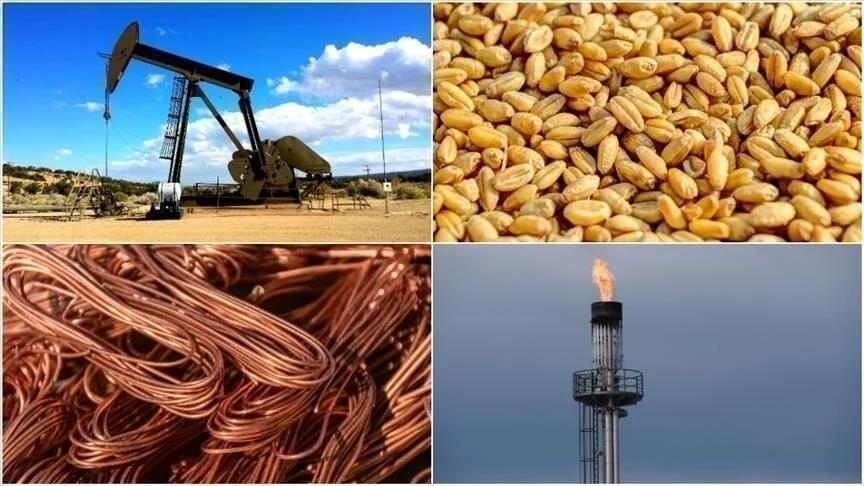Africa-Press – Eritrea. Commodity prices were mixed last week, primarily driven by trade war risks and uncertainties surrounding US President Donald Trump’s new tariff decisions, while geopolitical risks continued to mount globally.
Washington’s recent announcement to impose port fees on vessels linked to China has fueled uncertainty in global supply chains and the freight market, as these tariffs could increase freight costs across multiple sectors, including agriculture and energy.
The Federal Reserve left its policy rate unchanged at 4.25-4.50% on Wednesday, as expected. Fed Chair Jerome Powell stated that tariffs could slow the progress in combating inflation, while Trump’s call for a rate cut on social media raised concerns about potential conflict between Trump and the Fed.
Trump remarked that “the word flexibility is an important word” during a speech at the Oval Office last week, suggesting he might be open to negotiations regarding tariffs imposed on China.
The Organization for Economic Cooperation and Development (OECD) released its interim outlook report titled “Steering through Uncertainty” on Mar. 17.
The OECD revised its global economic growth forecast downward by 0.1% to 3.1% for 2025, while estimating US economic growth at 2.2% this year and 1.6% in 2026.
Gold may reach $3,500
Geopolitical developments dominated headlines last week, with contacts between Washington and Moscow aimed at ending the war in Ukraine sparking some optimism, while Israel’s ongoing military actions in Gaza fueled demand for safe-haven commodities.
Israel launched intensive airstrikes on Hamas targets in the Gaza Strip following the end of a two-month ceasefire, while the US attacked the Houthis, an Iranian-backed group in Yemen, due to threats to shipping lanes in the Red Sea.
Gold rose to a record high of $3,057 per ounce last week amid concerns about Trump’s aggressive tariffs and rising geopolitical risks, ending the week at $3,024.
Citi Research raised its three-month gold price target from $3,000 to $3,200 per ounce due to strong physical demand and increasing exchange-traded fund investments.
The bank said gold could reach $3,500 per ounce by the end of the year, driven by potential stagflation concerns or a hard landing in the US economy, which could spur further safe-haven demand.
US copper traders accelerate buying
Copper rose 4.7% per pound last week due to deteriorating market conditions caused by US tariffs and positive economic data from China.
Trump instructed the US Department of Commerce to investigate copper imports, which raised expectations for new tariffs, prompting US copper traders to accelerate purchases.
Analysts suggest a supply squeeze in the global copper market due to large shipments to the US and falling scrap exports, while other major consumers like China may drive prices higher in the competitive market.
While copper rose, other base metals fell. Zinc declined 1%, nickel 1.6%, lead 2.4%, and aluminum 2.5% per pound last week.
Oil on rise parallel to geopolitical risks
Brent crude oil rose 2.1% per barrel last week due to the end of the ceasefire in Palestine, security risks in the Red Sea, rising energy demand in China, Beijing’s expected stimulus packages, and uncertainties over US policies. A potential ceasefire between Ukraine and Russia somewhat limited the rise.
The OPEC+ group announced on March 20 that seven member states would cut production to offset recent price increases, which supported estimates of a potential decline in oil supply in the coming months.
Natural gas fell 3.4% amid expectations of surplus production, mild weather, and low heating demand.
USDA announces $10B support package
The US Department of Agriculture announced it would begin accepting applications for assistance to farmers affected by low commodity prices. The $10 billion package, provided under Congress’ temporary budget, aims to ease price pressures on wheat, corn, and soybean producers.
Wheat rose 0.2% per bushel due to drought and dust storms in the US, which created risks for cultivated areas. Corn climbed 1% as producers anticipated rising ethanol demand and higher profit margins. US corn acreage is expected to increase, according to S&P Global estimates.
Soybeans fell 0.8% and rice dropped 1.7% per bushel last week.
Sugar declined by 0.3% and cotton decreased by 0.4%, while coffee rose by 3.4% per pound. The price of cocoa per ton ended the week with a 0.4% decrease.
For More News And Analysis About Eritrea Follow Africa-Press







